News & Events
PIMS Applied Mathematics Seminar Series: Novel methods for geometric numerical integration
Title:
Novel methods for geometric numerical integration
Guest:
Dr. Alexander Bihlo
Memorial University
Dept. of Mathematics & Statistics
When: May 5 (Tuesday) at 3:30 PM
Where: Room 101 Arts Building
Abstract: Many models describing physical phenomena such as turbulence, waves, superconductivity and boundary layer dynamics are in the form of nonlinear partial differential equations that are hard to solve with analytical methods. In order to obtain a solution to such models, numerical methods have to be used. Unfortunately, standard numerical techniques such as Runge-Kutta methods often do not capture essential geometric properties of these differential equations and thus important features of these models are lost when they are discretized. Examples for such geometric features that standard numerical methods notoriously struggle with are symmetries and conservation laws.
Symmetries of differential equations are transformations that do not change the form of these equations. They are fundamental properties of the equations describing the laws of nature, which remain invariant under transformations such as scalings, rotations or shifts in space and time. Conservation laws have the form of continuity equations and state that particular quantities do not change over time in an isolated physical system (e.g. in the absence of fluxes over the boundaries of the system). Conservation laws are again linked to the physical properties of differential equations embodying that quantities such as energy or mass are preserved during the evolution of a conservative system.
Preserving geometric properties of differential equations numerically is usual required when long time integrations of physical systems are required. Methods that preserve such properties are called geometric numerical integrators. Thus, geometric numerical integrators play an important role in fields as diverse as astronomy, molecular dynamics and climate prediction.
In this talk I will present methods for the construction of geometric integrators that enable the preservation of symmetries and conservation laws of any system of differential equations.
